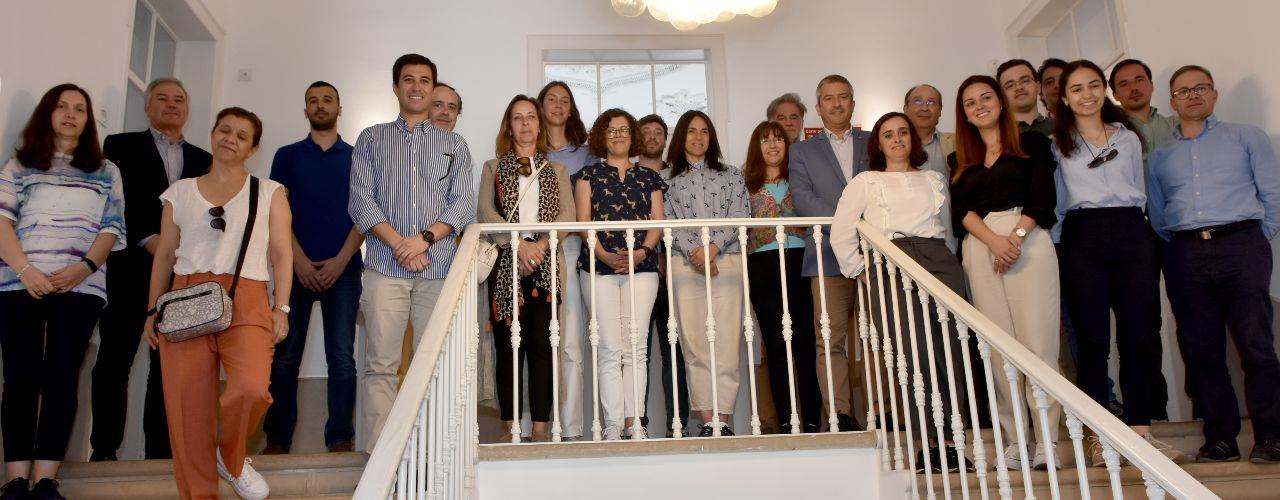Jardim das Comunidades and Infraquinta were the two crossing points of the technical visit that the CaPT2 network - Circularidade da Água:de Todos e para Todos carried out to the municipality of Loulé. Loulé received the partners - Águeda, Mértola, Oeiras, Oliveira de Frades, Ponte de Sor and Guimarães, via the Laboratório da Paisagem (the leading partner), with the municipaliy of Lagoa (Azores) also being part of this network. The expert who is monitoring the project, Eurico Neves, was also present on this journey, which aimed to make known, "in loco", to his peers, some of Loulé's work in terms of water sustainability.
“We are here with a common purpose: to take care of the greatest natural asset we have, which is water. We are all aware of the difficulties linked to water consumption. Each one, in their specificities, has different problems and constraints, but that is the wealth of these partnerships, being able to exchange experiences and understand what measures are being implemented in some places but in others would not make sense and vice versa ”, said the city councilor Carlos Carmo in the welcome session.
After a morning marked by a discussion on the more technical matters of the project and the current situation in each of the network's territories, in the afternoon the partners went out into the field to see two examples of good practices in this territory up close.
At Jardim das Comunidades, in Almancil, they were received by Manuela Moreira da Silva, the professor and researcher at the University of Algarve who has been leading a project that aims to make this public space green, which is the lung and central nucleus of this village. , a national reference in terms of sustainability of natural resources, whether in terms of water, energy or carbon sequestration.
“This garden will be increasingly prepared to respond to people's needs. And for that we have to incorporate scientific knowledge into its operation and use the technology we have available. For this we have to ensure that we manage this space using the least amount of water, the least amount of energy and maximizing its ability to sequester carbon and atmospheric pollutants”, she explained.
The creation of a “blue-green infrastructure” to manage water quality or an application that will allow for the quantification, for example, of carbon sequestration, showing the importance of vegetation in this garden are some of the ongoing initiatives that have the involvement of the local community.
In Quinta do Lago, the delegation was received by Pedro Pimpão, Chairman of the Board of Directors of the municipal company Infraquinta, an entity that has been responsible for a set of best practices valued and recognized in Portugal in terms of water efficiency and water reuse. This official and his team spoke to those present about the water supply system, management of green spaces, water reuse and smart irrigation in a territory of excellence.
“The reuse of water is, for us, one of the main areas of intervention. We have a very strong investment to go from 30% irrigation of green spaces through water reuse to 81%. In relation to water quality, for the sixth consecutive year, we received a distinction from ERSAR, the management entity in the fight against water losses, reaching a record value below 3%”, he highlighted.
At the end of the visit, the local coordinator of the project, Lídia Terra, made a positive assessment of this meeting and the appreciation by the partners: “Everyone told me that they were very pleased with what they saw! But for us it has also been an immense gain to participate in this type of project as it enhances our work and we learn a lot from the experience of other municipalities”.
Has Loulé already seen its Municipal Climate Action Plan approved, this official believes that it will be easier to create a Local Integrated Action Plan in the CaPT2 network. " Loulé has a well-aligned work strategy. At the moment, there are already ongoing actions and goals set for what they want in the future, and that could be the difference. This process of working in a network ends up being a validation with other partners of matter and projects on which we are already working, strengthening and deepening them", she clarified.
Remember that the CaPT2 network bases its strategy on the devolopment of a local governance model that integrates the different agents responsible for water management and that aims to include the citizen as an inducer of transformation towards a circular and participatory model. The ultimate objective is the design of a Local Plan of Integrated Action for the Urban Water Cycle that contributes to water management policies and the guidance of municipalities in the transition to a circular economy.
The network expert, Eurico Neves, highlighted the "heterogeneity" of the partners with "total realities".

